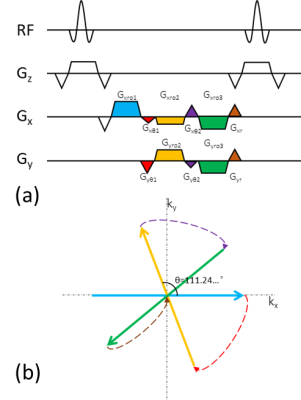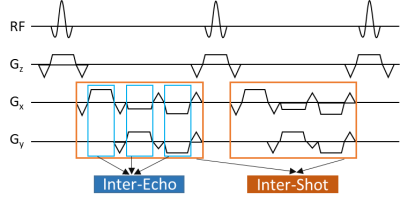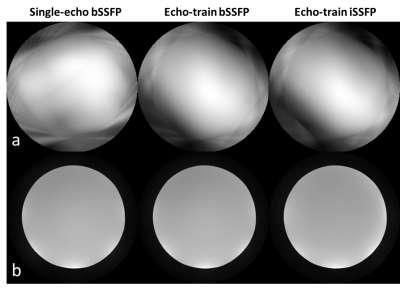0667
Echo-train radial SSFP with golden angle1Center for MR Research, University of Illinois at Chicago, Chicago, IL, United States, 2Department of Bioengineering, University of Illinois at Chicago, Chicago, IL, United States, 3Departments of Radiology and Neurosurgery, University of Illinois at Chicago, Chicago, IL, United States
Synopsis
Golden-angle radial sampling based on bSSFP is widely used in time-resolved imaging. The temporal resolution of this technique can be improved by extending a single-echo acquisition to echo-train acquisition per TR. In this study, we demonstrate an echo-train golden-angle radial bSSFP (ETGAR-bSSFP) sequence by acquiring multiple spokes in k-space to improve the temporal resolution. In addition, we introduce an integrated phase correction method and a variation of ETGAR-bSSFP to manage the image artifacts. Results from phantom and human brain have showed high quality images can be acquired from the ETGAR-bSSFP sequences and be potentially used for dynamic imaging studies.
Introduction:
Golden-angle radial sampling provides a nearly uniform coverage of k-space and high temporal incoherence for any arbitrary number of consecutive k-space lines1. This sampling approach is particularly valuable for dynamic imaging studies using continuous data acquisition and retrospective reconstruction to provide a flexible temporal resolution1–3. As such, the golden-angle ordering scheme has been increasingly used in various time-resolved applications, including cardiac imaging and single-scan T1- and T2-mapping4–10. The technique was initially implemented in a balanced steady state free precession (bSSFP) pulse sequence by acquiring one radial spoke per TR1. Despite many advantages of this implementation, the temporal resolution of the single-spoke approach can be a limitation for capturing fast dynamic processes. To improve temporal resolution, we herein report a multi-spoke sequence for golden-angle radial bSSFP acquisition by utilizing a short echo train with inter-echo steering gradient pulses11 to acquire multiple spokes in k-space. The use of an echo train to increase the number of spokes per TR leads to increased sensitivity to banding artifacts due to off-resonance effects and eddy-current artifacts arising from additional gradient switching. In this study, we have addressed these problems by incorporating an integrated SSFP (iSSFP) technique12 and a systematic phase correction method into the echo-train golden-angle radial bSSFP (ETGAR-bSSFP) sequence.Methods:
Pulse sequence design: ETGAR-bSSFP employs a train of n gradient echoes separated by steering blip gradient pulses to orient adjacent k-space lines within a TR by the golden angle θ (111.24…°). Figure 1 shows three readout gradients in the echo train (a) and the corresponding k-space lines (b) color-coded with blue, yellow, and green. The red and purple gradients between the adjacent gradient echoes are “steering” pulses, which are used to steer the k-space trajectory11. The brown gradients at the end of the echo train rewind the phase along the kx- and ky-directions, as required by bSSFP. To generate the remaining sets of k-space lines in subsequent TRs, the rotation matrix of the scanner was employed with a rotation angle increment of 3θ (i.e. 3θ - 2π) per TR without the need of designing additional steering and rewinding gradients. To remove banding artifacts, an ETGAR-iSSFP sequence was developed analogously by placing a gradient along the z-axis at the end of each TR to dephase the spins by 2π within a voxel12.Phase corrections: Correction of two types of phase errors – inter-echo and inter-shot phase errors – was incorporated into image reconstruction (Figure 2). Inter-echo phase errors occur among the echoes in the echo train within a TR, similar to those in EPI. Inter-shot phase errors arise between the spokes acquired in different TRs, which can be caused by motion or eddy current perturbation on a longer time-scale. The central k-space region with over sampling was used to perform both inter-echo and inter-shot phase error corrections. After phase corrections, image reconstruction was performed by re-gridding, density compensation, and FFT11.
Experimental studies: The ETGAR-bSSFP and ETGAR-iSSFP sequences were implemented on a 3T scanner (GE MR750) with an 8-channel head coil and evaluated on phantoms and healthy human brains. In the phantom experiment, axial images were acquired using the following parameters: FOV = 22x22cm2, matrix size = 256x256, number of spokes = 384, slice thickness = 5mm, BW = ±62.5kHz, echo-train length (ETL) = 3, TR = 13.9ms and TEs = 2.5/6.2/9.9ms. For comparison, images were also acquired with a conventional single-echo bSSFP sequence using the same parameters except for that TR/TE = 6/2.4ms. In the human brain experiment, the same imaging protocols were employed.
Results:
The phantom images obtained using single-echo golden-angle radial bSSFP, ETGAR-bSSFP, and ETGAR-iSSFP are displayed in Figure 3 before and after applying the integrated phase corrections. The phase correction strategy effectively removed the image artifacts, resulting in considerably improved image quality for all three sequences. Compared to the conventional single-echo bSSFP, both ETGAR-bSSFP and ETGAR-iSSFP produced comparable image quality. The moderate SNR reduction in ETGAR-bSSFP and ETGAR-iSSFP (see figure caption) was a reflection of increased average TEs and decreased scan times. The brain images acquired with the three sequences are shown in Figure 4. In comparison with single-echo bSSFP, ETGAR-bSSFP reduced the scan times without a noticeable reduction in SNR. However, the susceptibility/banding artifacts were considerably exacerbated due to the increased sensitivity to off-resonance. The artifacts were successfully eliminated in ETGAR-iSSFP.Discussion and conclusion:
We have demonstrated a new sequence to extend single-echo acquisition in golden-angle radial SSFP to echo-train acquisition, allowing multiple k-space spokes to be acquired in a single TR to reduce the overall scan times. Although the scan time reduction has been moderate (e.g., 17%) due to the use of steering gradient pulses, further scan time reduction can be achieved with high-performance gradient hardware13 or alternative k-space trajectories, such as the tiny golden-angle trajectory14. We have also demonstrated that an integrated phase correction strategy was critical to good image quality and that incorporation of iSSFP effectively eliminated the off-resonance artifacts. With further improvements, the echo train approach described herein is expected to expand the scope of applications of golden-angle radial SSFP for time-resolved studies.Acknowledgements
This work was supported in part by the National Institutes of Health (5R01EB026716-01 and 1S10RR028898-01). The authors are grateful to Dr. M. Muge Karaman, and Guangyu Dan for technical support or helpful discussions.References
1. Winkelmann S, Schaeffter T, Koehler T, et al. An optimal radial profile order based on the golden ratio for time-resolved MRI. IEEE Trans Med Imaging. 2007.
2. Usman M, Atkinson D, Odille F, et al. Motion corrected compressed sensing for free-breathing dynamic cardiac MRI. Magn Reson Med. 2013.
3. Chan RW, Ramsay EA, Cheung EY, et al. The influence of radial undersampling schemes on compressed sensing reconstruction in breast MRI. Magn Reson Med. 2012.
4. Hopfgartner AJ, Tymofiyeva O, Ehses P, et al. Dynamic MRI of the TMJ under physical load. Dentomaxillofacial Radiol. 2013.
5. Feng L, Grimm R, Block KT obia., et al. Golden-angle radial sparse parallel MRI: combination of compressed sensing, parallel imaging, and golden-angle radial sampling for fast and flexible dynamic volumetric MRI. Magn Reson Med. 2014.
6. Ehses P, Seiberlich N, Ma D, et al. IR TrueFISP with a golden-ratio-based radial readout: Fast quantification of T1, T2, and proton density. Magn Reson Med. 2013.
7. Paul J, Divkovic E, Wundrak S, et al. High-resolution respiratory self-gated golden angle cardiac MRI: Comparison of self-gating Methods in combination with k-T SPARSE SENSE. Magn Reson Med. 2015.
8. Scott AD, Boubertakh R, Birch MJ, et al. Adaptive averaging applied to dynamic imaging of the soft palate. Magn Reson Med. 2013.
9. Liu J, Spincemaille P, Codella NCF, et al. Respiratory and cardiac self-gated free-breathing cardiac CINE imaging with multiecho 3D hybrid radial SSFP acquisition. Magn Reson Med. 2010.
10. Song HK, Dougherty L. k-Space weighted image contrast (KWIC) for contrast manipulation in projection reconstruction MRI. Magn Reson Med. 2000.
11. Srinivasan G, Rangwala N, and Zhou XJ. Steer-PROP: a GRASE-PROPELLER sequence with interecho steering gradient pulses, Magn Reson Med. 2018.
12. Sun KB, Xue R, Zuo ZT, et al. Integrated SSFP for functional brain mapping at 7 T with reduced susceptibility artifact. J Magn Reson. 2017.
13. Rededer SB, McVeigh ER. The effect of high performance gradients on fast gradient echo imaging. Magn Reson Med. 1994.
14. Wundrak S, Paul J, Ulrici J, et al. A small surrogate for the golden angle in time-resolved radial MRI based on generalized fibonacci sequences. IEEE Trans Med Imaging. 2015.
Figures



